
What Are the Risks of Low Beds?
📋 KEY TAKEAWAYS
| Risk Category | Low Low Beds | Standard Hospital Beds |
|---|---|---|
| Caregiver Strain | High when bed remains in lowest position | Lower with proper height adjustment |
| Floor Hazards | Increased exposure to floor contamination | Minimal exposure at standard heights |
| Entrapment | Risk of limbs trapped under ultra-low frame | Standard entrapment zones managed by design |
| Emergency Access | More difficult in lowest position | Better access at standard heights |
| Transfer Challenges | Difficult from lowest position | Optimal height can be selected |
Best Solution: Medacure Ultra Low Hospital Bed ULB7/30-CLS – Features 7"-30" height range with floor lock system
For Maximum Height Range: Hi-Lo Hospital Beds – Full height adjustability to balance safety and caregiver access
Key Prevention Measure: Only use lowest position when necessary for fall prevention, adjust height for care tasks
The Risks of Low Beds, while excellent for reducing fall injuries in elderly and at-risk patients, present several significant risks that caregivers and healthcare providers should understand.
The primary risks include caregiver strain from working at extremely low heights, poor access during emergencies, increased exposure to floor contaminants, potential entrapment hazards, and difficulties with transfers.
The ideal solution is using a hi-lo hospital bed that can be lowered for safety during sleep but raised for care activities, like the Medacure Ultra Low Hospital Bed ULB7/30-CLS.
Understanding the potential drawbacks of low low beds is essential for making informed care decisions that balance fall prevention with other safety and practical considerations. This article examines these risks in detail and provides solutions for mitigating them while still protecting vulnerable patients from fall injuries.
Caregiver Strain and Ergonomic Issues
The most significant risk of low low beds is the physical strain they place on caregivers who must provide care while the bed is in its lowest position.
Back and Neck Strain
When caregivers work with a patient in a low low bed that's positioned at its minimum height (typically 7" to 11" from the floor):
- Severe bending: Caregivers must bend at extreme angles to reach patients
- Prolonged stooping: Tasks like bathing, changing, and care delivery require extended periods in awkward positions
- Spine compression: The unnatural angles create intense pressure on lumbar vertebrae
- Muscle fatigue: Supporting the upper body while bent creates rapid muscle exhaustion
- Long-term injury risk: Repeated strain increases likelihood of chronic back conditions
According to occupational health guidelines, the optimal working height for caregiving tasks is between 25"-30" from the floor, far higher than low low bed minimum heights.
Impact on Care Quality
These ergonomic challenges can directly affect the quality of care provided:
- Rushed procedures: Caregivers may hurry through tasks due to discomfort
- Limited thoroughness: Difficult positioning may reduce attention to detail
- Inconsistent care: Some tasks might be skipped or abbreviated
- Care avoidance: Non-critical care might be postponed due to ergonomic challenges
- Caregiver turnover: Physical strain contributes to burnout and staff changes
| Caregiver Task | Risk at Lowest Position (7"-11") | Risk at Optimal Height (25"-30") |
|---|---|---|
| Bathing | High - Extended bending for 15+ minutes | Low - Natural standing posture |
| Dressing | High - Awkward reaching across patient | Low - Proper reach mechanics possible |
| Wound Care | Very High - Precision tasks with poor posture | Low - Proper visual angle and posture |
| Feeding | Moderate - Extended sitting in low position | Low - Comfortable seated position |
| Linen Changes | High - Extended bending and lifting | Low - Proper body mechanics possible |
Solution: Height Adjustability
The ideal solution to prevent caregiver strain while maintaining fall protection is using a true hi-lo hospital bed that provides:
- Full range of height: Adjustable from ultra-low (7"-11") to ergonomic working height (25"-30")
- Easy controls: Quick adjustment capabilities for different tasks
- Lock functionality: Secure positioning at preferred heights
- Caregiver training: Proper use of height adjustment for different procedures
- Task planning: Grouping care activities to minimize height changes
The Medacure Ultra Low Hospital Bed ULB7/30-CLS exemplifies this solution with its 7"-30" height range and stable floor lock system, allowing for optimal positioning during both sleep and care delivery.
Floor Contamination and Hygiene Concerns
When a bed is positioned extremely close to the floor, it creates additional exposure to floor-level contaminants.
Increased Pathogen Exposure
Low low beds place patients and bed components closer to floor-level contamination:
- Dust accumulation: Floor dust more easily transfers to bedding
- Airborne particles: Many contaminants concentrate near floor level
- Splashes and spills: Greater exposure to cleaning solutions and bodily fluids
- Pest access: Easier access for insects and other pests
- Cross-contamination: Increased transfer between floor and bed surfaces
Healthcare environments with high sanitation standards must be particularly careful with beds positioned at extremely low heights.
Underbed Cleaning Challenges
The minimal clearance under low low beds creates specific hygiene challenges:
- Limited access: Difficult to clean thoroughly underneath
- Tool restrictions: Standard cleaning equipment may not fit
- Visual limitations: Can't easily see contamination under the bed
- Moisture trapping: Potential for dampness and bacterial growth
- Mechanical interference: Bed mechanisms may block cleaning access
Hospital studies have found that under-bed areas are frequently neglected during cleaning routines, with the problem exacerbated when clearance is minimal.
Environmental Considerations
Different environmental factors affect the contamination risk of low low beds:
- Carpet vs. hard flooring: Carpet harbors more contaminants near low beds
- Air circulation patterns: Poor ventilation concentrates particles at floor level
- Humidity levels: Higher humidity increases microbial growth potential
- Traffic volumes: Busier areas create more floor contamination
- Cleaning protocols: Frequency and method of floor cleaning impacts risk
Solution: Integrated Protection and Height Management
To mitigate hygiene risks while maintaining fall safety:
- Sealed underbeds: Enclosed designs that prevent contaminant accumulation
- Antimicrobial surfaces: Materials that resist bacterial growth
- Appropriate height: Raising bed for cleaning then lowering for sleep
- Enhanced cleaning protocols: Specialized tools for ultralow clearances
- Environmental controls: Proper ventilation and humidity management
The Medacure Ultra Low Hospital Bed ULB7/30-CLS addresses these concerns with its height adjustability, allowing for proper floor cleaning access when raised while still providing ultra-low positioning when needed for fall prevention.
Entrapment and Pinch Point Hazards
Low low beds create unique entrapment risks not typically found in standard hospital beds.
Frame and Floor Entrapment
When beds descend to 7" or less from the floor, new entrapment zones emerge:
- Under-bed space: Limbs can become trapped in the narrow gap between frame and floor
- Mechanism pinch points: Moving parts create crushing hazards during height changes
- Edge compression: Items or body parts can be compressed against floors during lowering
- Frame gaps: Ultra-low frames may have unique openings not found in standard beds
- Side rail interactions: Different entrapment risks when side rails are used with ultra-low heights
The FDA identifies seven entrapment zones in hospital beds, with ultra-low models creating additional concerns in Zone 7 (between the bed and floor).
Mobility Device Interference
Low low beds create challenges with mobility equipment:
- Walker clearance: Difficult to position walkers effectively at ultra-low heights
- Wheelchair transfers: Nearly impossible from lowest positions
- Lift access: Many patient lifts cannot access patients at extremely low heights
- Support poles: IV poles and other equipment may not adjust to ultra-low positions
- Assist devices: Trapeze bars and other mobility aids may be ineffective at lowest heights
Hidden Hazards
Several less obvious entrapment risks exist with low low beds:
- Cord management: Power cords and call buttons can become trapped in mechanisms
- Personal items: Patient belongings may fall and become crushed during height changes
- Bedding entrapment: Sheets and blankets can catch in frame components
- Floor mat interaction: Safety mats may interfere with height adjustment
- Structural clearances: Room fixtures like baseboards may create pinch points
Solution: Proper Design and Height Management
Mitigating entrapment risks requires:
- Enclosed frame design: Eliminating gaps and pinch points
- Proper clearance: Maintaining minimum safe distances between components
- Safety sensors: Obstacle detection during height adjustment
- Staff training: Understanding and managing unique entrapment zones
- Appropriate accessories: Using equipment designed for ultra-low compatibility
Modern hi-lo hospital beds like the Medacure Ultra Low Hospital Bed ULB7/30-CLS incorporate safety features that address these concerns while maintaining the fall prevention benefits of ultra-low positioning.
Emergency Access and Response Limitations
The extremely low position of low low beds can create significant challenges during medical emergencies.
CPR and Resuscitation Difficulties
When emergency procedures are needed, low low beds present several obstacles:
- Inadequate firmness: Floor-level beds may lack the firm surface needed for effective CPR
- Access challenges: Responders must work from kneeling positions
- Height adjustment delays: Time lost raising the bed to working height
- Equipment limitations: Crash carts and resuscitation equipment designed for standard heights
- Team positioning: Difficult to position multiple responders effectively
Studies show that CPR quality deteriorates significantly when performed on surfaces lower than standard bed height.
Transfer Constraints During Emergencies
Moving patients quickly during emergencies becomes more challenging:
- Stretcher incompatibility: Standard stretchers cannot align with ultra-low beds
- Lifting requirements: Emergency staff must lift from floor level
- Confined positioning: Limited space for emergency responders
- Manual handling risks: Increased injury risk for staff during emergency lifts
- Time delays: Slower transfers when rapid response is critical
Solution: Quick-Raise Functionality
Modern safety features address emergency concerns:
- Emergency height control: One-touch rapid elevation to CPR position
- Backup power: Battery systems ensure height adjustment during power outages
- Staff training: Procedures for emergency management with ultra-low beds
- Quick-release mechanisms: Rapid removal of side rails and accessories
- Transfer boards: Specialized equipment for low-height transfers
The Medacure Ultra Low Hospital Bed ULB7/30-CLS addresses these concerns with quick-adjustment capabilities that allow for rapid height changes in emergency situations while still providing ultra-low positioning for fall prevention.
Patient Transfer and Mobility Challenges
Ultra-low bed heights can significantly complicate patient transfers and mobility.
Standing Transfer Difficulties
When a bed is in its lowest position, several transfer problems emerge:
- Excessive squat depth: Patients must rise from a position much lower than typical chair height
- Momentum challenges: Difficult to generate standing momentum from ultra-low position
- Balance issues: Greater risk of destabilization during standing attempt
- Assistive device misalignment: Walkers and canes positioned too high relative to the bed
- Caregiver assistance limitations: Helpers must lift rather than guide
Research indicates that optimal transfer height for most elderly individuals is 19"-23" from floor, significantly higher than low low bed minimum heights.
Lateral Transfer Complications
Bed-to-wheelchair and other lateral transfers become problematic:
- Height mismatch: Significant difference between bed and wheelchair heights
- Transfer board angle: Too steep for safe sliding transfers
- Lift equipment clearance: Many lifts cannot reach under ultra-low beds
- Surface friction: Increased drag during lateral movements from lower heights
- Physical strain: Greater force required from caregivers
| Transfer Type | Risk at Lowest Position (7"-11") | Risk at Transfer Height (19"-23") |
|---|---|---|
| Bed to Standing | High - Excessive squat depth required | Low - Natural chair-height rising |
| Bed to Wheelchair | Very High - Major height mismatch | Low - Heights can be matched |
| Bed to Commode | High - Most commodes higher than bed | Low - Heights can be aligned |
| Bed to Stretcher | Very High - Major lift required | Low - Lateral slide possible |
| Bed to Chair | High - Significant height difference | Low - Similar surface heights |
Psychological Impacts
The ultra-low position can affect patient psychology regarding mobility:
- Perceived vulnerability: Feeling "too low" to stand safely
- Increased dependency: Greater reliance on caregiver assistance
- Motivation reduction: Less inclination to attempt independent transfers
- Spatial disorientation: Altered perspective from floor-level position
- Confidence decrease: Reduced self-efficacy regarding mobility
Solution: Strategic Height Management
Effective use of hi-lo hospital beds requires thoughtful height management:
- Task-appropriate heights: Lowering only during sleep and supervised rest
- Transfer optimization: Raising to individual-specific transfer height for mobility
- Gradual progression: Incremental height adjustment for rehabilitation
- Patient education: Clear explanation of height adjustment purposes
- Consistent protocols: Standardized height management procedures
The Medacure Ultra Low Hospital Bed ULB7/30-CLS with its 7"-30" range allows for optimal positioning during both rest periods (ultra-low for fall safety) and transfers (appropriate height for specific mobility needs).
Psychological and Social Impact
Ultra-low bed positioning can affect patient dignity, autonomy, and social interaction.
Dignity and Perspective Concerns
Being positioned at floor level can create psychological discomfort:
- Power dynamics: Patient feels "looked down upon" by standing caregivers
- Infantilization: Association with cribs or childlike positioning
- Institutional feeling: Reinforces medical rather than home-like environment
- Visual limitations: Restricted view of surroundings from very low position
- Psychological regression: May contribute to dependent behaviors
Healthcare psychology studies show that bed height impacts patient perception of care quality and personal dignity.
Social Interaction Barriers
Ultra-low positioning can impede normal social engagement:
- Conversation difficulties: Awkward angles for face-to-face communication
- Visitor seating challenges: Standard chairs too high relative to the low bed
- Social withdrawal: Increased reluctance to engage from compromised position
- Participation limitations: Difficulty joining family activities from floor level
- Visibility issues: Less visible to passing staff and visitors
Independence Perception
Beyond physical challenges, low positioning affects perceived independence:
- Environmental control reduction: Decreased access to surroundings
- Helplessness reinforcement: Positioning suggests disability
- Agency limitation: Reduced ability to interact with environment
- Status diminishment: Association with dependent status
- Identity impact: Conflict with self-perception as capable
Solution: Patient-Centered Height Management
Balancing safety with psychological wellbeing requires:
- Daytime elevation: Raising bed to social heights during waking hours
- Patient control: Providing user control over height when safe
- Appropriate furniture: Visitor seating that aligns with bed height
- Environmental design: Room layout that accommodates variable heights
- Dignified explanation: Clear communication about height purposes
Modern hospital beds with full height adjustment capability, like the Medacure Ultra Low Hospital Bed ULB7/30-CLS, allow for appropriate positioning that maintains dignity and social interaction while still providing fall protection when needed.
Mechanical and Practical Limitations
Low low beds present several operational and practical challenges beyond patient care considerations.
Mechanical Vulnerability
The mechanisms required for ultra-low positioning create specific concerns:
- Complex hydraulics/motors: More components that can fail
- Floor-level mechanisms: Greater exposure to dust and debris
- Overextended components: Systems operating at extreme ranges
- Weight distribution challenges: Different stress patterns at lowest heights
- Clearance limitations: Reduced space for mechanical operation
Maintenance records show that ultra-low mechanisms require more frequent servicing than standard height adjustment systems.
Room Integration Issues
Ultra-low beds interact differently with room environments:
- Door clearance: May block door swing in lowest position
- Wall damage: Greater potential for wall contact during adjustments
- Baseboard interference: Potential for catching on room trim
- Floor irregularity sensitivity: More affected by uneven flooring
- Electrical access: Power cord management more challenging at floor level
Equipment Compatibility
Many standard medical devices are not designed for ultra-low bed heights:
- Overbed tables: Cannot fit under ultra-low positions
- Monitoring equipment: Mounting at inappropriate heights
- Therapy devices: Exercise and therapy equipment designed for standard heights
- Medical carts: Cannot access patients at lowest positions
- Standard accessories: IV poles, oxygen holders, etc., not designed for floor-level use
Solution: Specialized Design and Accessories
Addressing practical limitations requires:
- Purpose-built systems: Equipment designed specifically for ultra-low operation
- Enhanced durability: Reinforced components for floor-level operation
- Compatibility planning: Room layout and equipment selection for low bed use
- Advanced mechanisms: Simplified designs with fewer failure points
- Height memory: Programmable settings for consistent positioning
The best hi-lo hospital beds, including the Medacure Ultra Low Hospital Bed ULB7/30-CLS, address these issues with robust design, wide height ranges, and compatibility with standard medical accessories.
Balancing Benefits and Risks: Best Practices
Despite their risks, low low beds remain valuable tools for fall prevention when used correctly.
Individualized Assessment
Not every patient requires ultra-low positioning:
- Fall risk evaluation: Standardized tools to identify true fall risks
- Mobility assessment: Determining appropriate transfer heights
- Cognitive status: Evaluating understanding of bed safety
- Care requirements: Analyzing frequency and type of care needed
- Environmental factors: Room layout, flooring, and space considerations
Research shows targeted use of low low beds is more effective than universal application.
Strategic Height Management
The key to minimizing risks while maintaining benefits is proper height management:
- Time-based protocols: Ultra-low only during sleep and rest
-
Task-specific heights: Different positions for care, transfers, and socialization
-
Activity scheduling: Grouping similar tasks to minimize height changes
- Consistent communication: Clear directions about current height needs
- Patient involvement: Including patient preferences in height decisions
Staff Training and Education
Proper training is essential for safe low low bed use:
- Ergonomic techniques: Methods for working safely at floor level when necessary
- Height adjustment proficiency: Quick and effective bed positioning
- Emergency protocols: Procedures for rapid response in low bed situations
- Transfer training: Safe techniques for different height scenarios
- Risk awareness: Understanding and mitigating specific low bed hazards
Complementary Safety Measures
Low low beds work best as part of a comprehensive fall prevention strategy:
- Floor mats: Impact-absorbing surfaces alongside beds
- Motion alarms: Early warning of exit attempts
- Appropriate side rails: Safety rails designed for ultra-low positions
- Environmental modifications: Room arrangements that minimize hazards
- Regular reassessment: Ongoing evaluation of bed height needs
Our Top Recommendation: The Balanced Approach
After analyzing the risks and benefits of low low beds, we recommend the Medacure Ultra Low Hospital Bed ULB7/30-CLS as the optimal solution for most care environments. This advanced bed offers:
- Full height range: 7" ultra-low position for fall safety to 30" caregiver height
- Floor lock system: Stability at any height
- Smooth transitions: Easy adjustment between positions
- Durable construction: Reliable operation at all heights
- Safety features: Designed to minimize entrapment risks
When used with proper protocols that balance fall prevention with other safety concerns, hi-lo hospital beds provide the best combination of benefits while minimizing the risks discussed in this article.
Frequently Asked Questions
When should low low beds be used at their minimum height?
Low low beds should be at minimum height only during sleep and unsupervised rest periods when fall risk is highest.
Can ergonomic tools help caregivers work with low low beds?
Yes, kneeling pads, extended reach tools, and height-adjustable seating can reduce strain, but raising the bed remains the safest option.
Are there specific cleaning protocols for low low beds?
Use narrow vacuum attachments, microfiber mops, and regularly elevate the bed for thorough underbed cleaning to minimize contamination.
What's the biggest risk of keeping a bed at the lowest position all day?
Caregiver back injury from poor ergonomics is the most significant risk, followed by reduced care quality due to difficult access.
Are floor mats still needed with ultra-low beds?
Yes, impact-absorbing floor mats provide additional protection for falls from even the lowest beds and are recommended for complete safety.
How do you handle emergencies with patients in low low beds?
Immediately raise the bed to working height using the emergency controls before beginning CPR or emergency procedures.









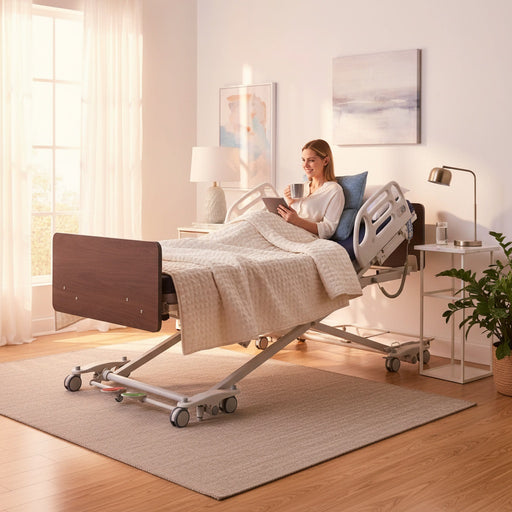
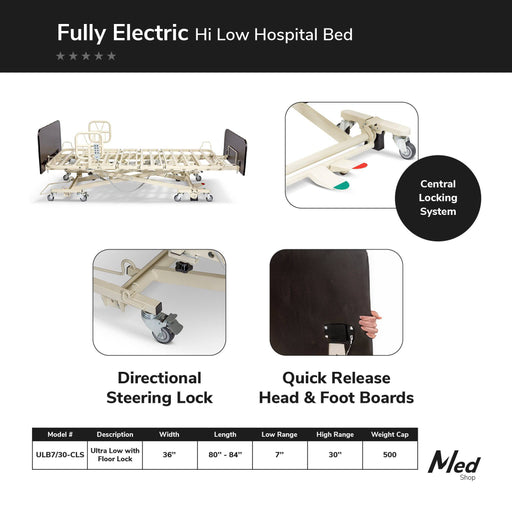
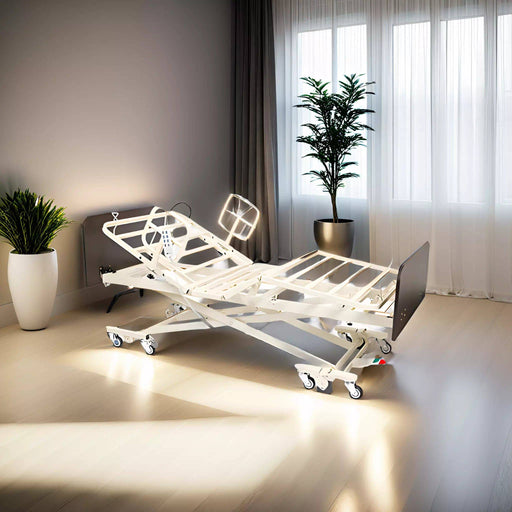


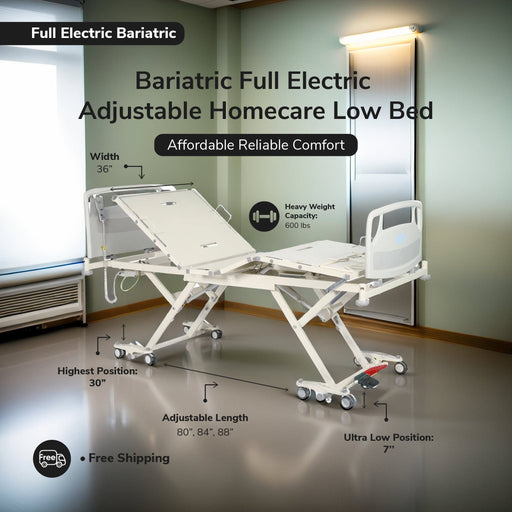
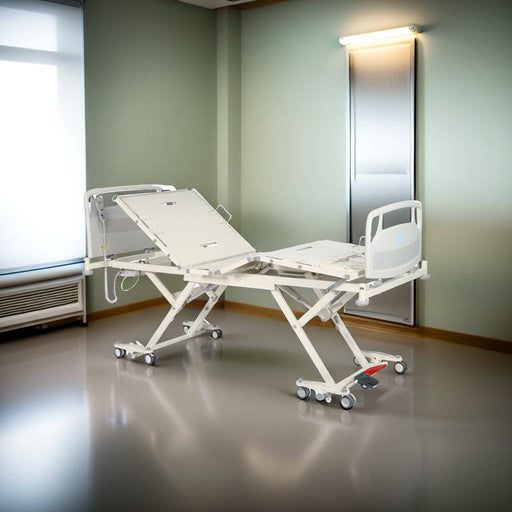
Leave a comment